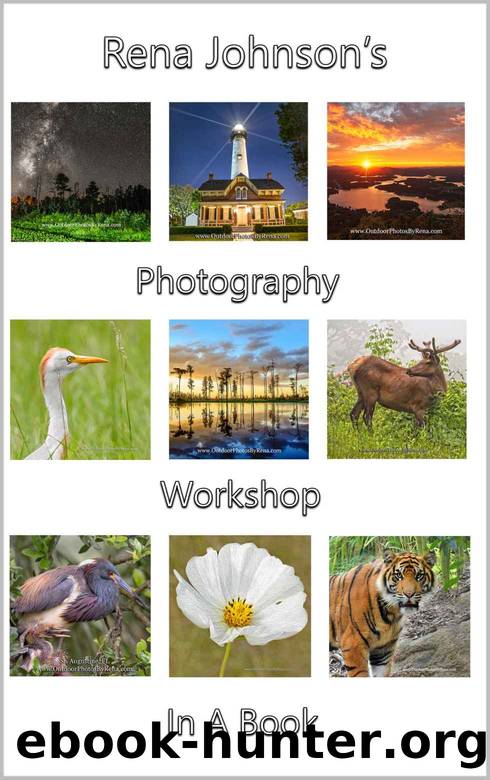Rena Johnson's Photography Workshop in a Book by Rena Johnson

Author:Rena Johnson [Johnson, Rena]
Language: eng
Format: azw3
Published: 2019-01-11T16:00:00+00:00
Scene Modes:
As I mentioned earlier, the little âRunning Manâ button, otherwise known as the sport mode, was a huge help when I first started shooting. I knew if something was moving, I could use that button and most likely it would not end up blurry as far as motion was concerned. I soon began playing with all of the other scene modes and in doing so, I was able to watch my photography get better and better with each new shoot.
Sports Mode:
This one is sometimes also referred to as Kids, Pets, or Action mode. On occasion these are split up into multiple modes. However, the icon for it is sometimes green and almost always indicates some sort of action.
The settings that are used here begin with a faster shutter speed so that the camera can stop the action of moving objects. All other settings are chosen to compliment that shutter speed in order to get a fairly correct exposure. This usually involves using either a larger aperture or higher ISO or both.
Landscape Mode:
Landscape mode focuses on using a larger depth of field to get a lot more of your overall scene in focus. It does this by using a smaller aperture (larger f/# such as f/22). We will discuss this in greater detail a bit later.) Thereby, focusing on the aperture like this and using a smaller one, it allows less light into the camera, which would make the exposure darker. To compensate for this, the camera will automatically slow down the shutter speed, allowing more light to come in that way. Using this shot with anything moving in the scene, will most likely cause motion blur. As a side note, if you are using auto focus, this mode will usually choose infinity (or the farthest point) as the point of primary focus.
Portrait Mode:
Portrait mode works almost exactly opposite to landscape mode. Instead of the camera trying to get everything in the scene in focus, it produces a much shallower depth of field so that everything behind and/or in front of your subject is out of focus. This will draw more attention to the person or subject that you are focusing on shooting. It does this by using a larger aperture (smaller f/# such as f/4, etc.) Because using the larger aperture lets in more light, this will result in the use of a faster shutter speed (which is good because people do move) and hopefully a lower ISO depending on the amount of available light, which will produce less noise or grain in your image.
For the best results using this mode, try to have your subject stand in front of a non-distracting background and with a bit of distance between them so that your subject will be clearly defined.
Newer camera models even have facial recognition and will seek out your subject in this mode or when this option is chosen. Pay special attention to this if there happens to be more than one person in your scene, especially if
Download
This site does not store any files on its server. We only index and link to content provided by other sites. Please contact the content providers to delete copyright contents if any and email us, we'll remove relevant links or contents immediately.
Shoot Sexy by Ryan Armbrust(17134)
Portrait Mastery in Black & White: Learn the Signature Style of a Legendary Photographer by Tim Kelly(16479)
Adobe Camera Raw For Digital Photographers Only by Rob Sheppard(16381)
Photographically Speaking: A Deeper Look at Creating Stronger Images (Eva Spring's Library) by David duChemin(16153)
Bombshells: Glamour Girls of a Lifetime by Sullivan Steve(13102)
Art Nude Photography Explained: How to Photograph and Understand Great Art Nude Images by Simon Walden(12340)
Perfect Rhythm by Jae(4617)
Pillow Thoughts by Courtney Peppernell(3384)
The Book of Joy by Dalai Lama(3212)
Good by S. Walden(2910)
The Pixar Touch by David A. Price(2737)
Fantastic Beasts: The Crimes of Grindelwald by J. K. Rowling(2540)
A Dictionary of Sociology by Unknown(2516)
Humans of New York by Brandon Stanton(2376)
Read This If You Want to Take Great Photographs by Carroll Henry(2299)
Stacked Decks by The Rotenberg Collection(2267)
On Photography by Susan Sontag(2128)
Photographic Guide to the Birds of Indonesia by Strange Morten;(2086)
Insomniac City by Bill Hayes(2080)
